2005 FORD F250 SUPER DUTY air condition
[x] Cancel search: air conditionPage 209 of 312
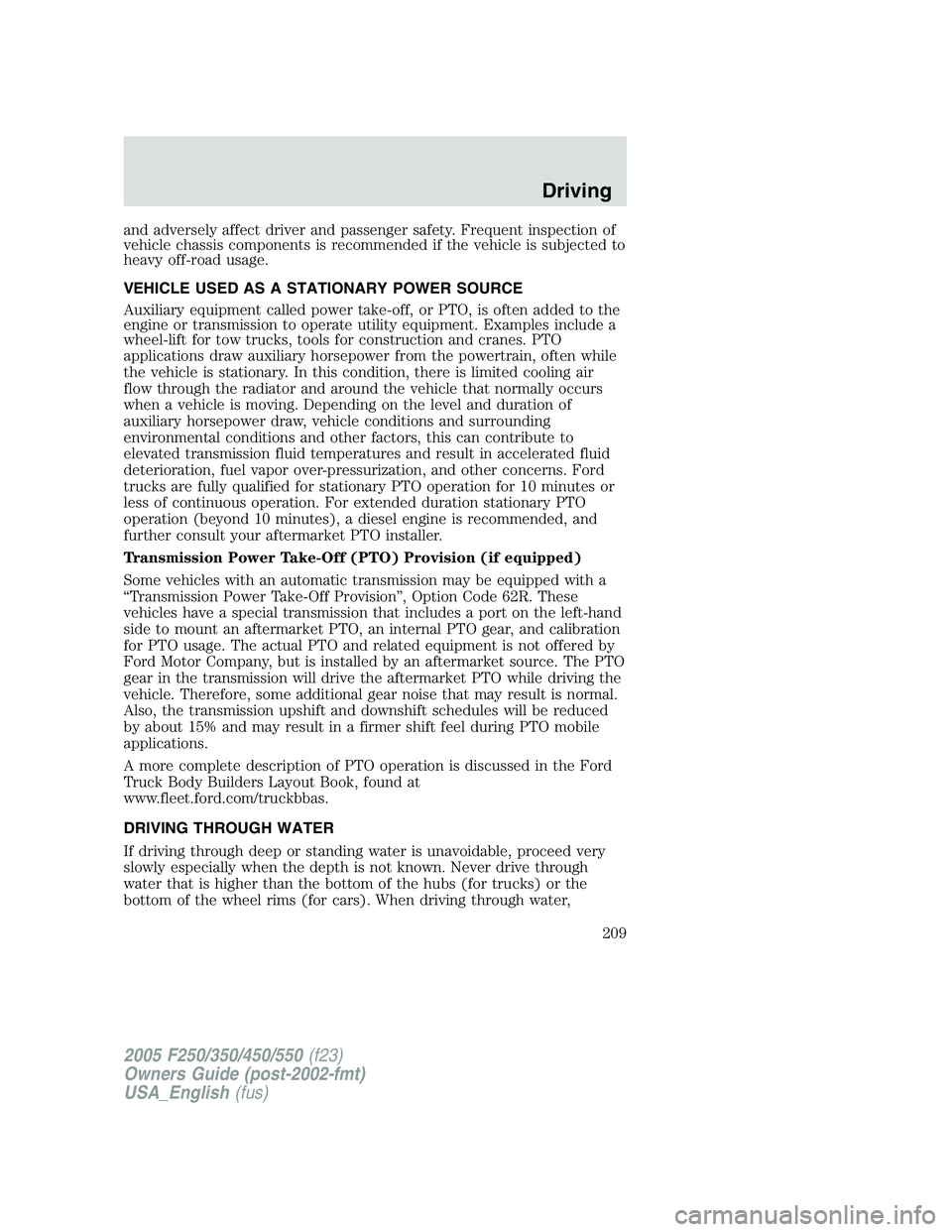
and adversely affect driver and passenger safety. Frequent inspection of
vehicle chassis components is recommended if the vehicle is subjected to
heavy off-road usage.
VEHICLE USED AS A STATIONARY POWER SOURCE
Auxiliary equipment called power take-off, or PTO, is often added to the
engine or transmission to operate utility equipment. Examples include a
wheel-lift for tow trucks, tools for construction and cranes. PTO
applications draw auxiliary horsepower from the powertrain, often while
the vehicle is stationary. In this condition, there is limited cooling air
flow through the radiator and around the vehicle that normally occurs
when a vehicle is moving. Depending on the level and duration of
auxiliary horsepower draw, vehicle conditions and surrounding
environmental conditions and other factors, this can contribute to
elevated transmission fluid temperatures and result in accelerated fluid
deterioration, fuel vapor over-pressurization, and other concerns. Ford
trucks are fully qualified for stationary PTO operation for 10 minutes or
less of continuous operation. For extended duration stationary PTO
operation (beyond 10 minutes), a diesel engine is recommended, and
further consult your aftermarket PTO installer.
Transmission Power Take-Off (PTO) Provision (if equipped)
Some vehicles with an automatic transmission may be equipped with a
“Transmission Power Take-Off Provision”, Option Code 62R. These
vehicles have a special transmission that includes a port on the left-hand
side to mount an aftermarket PTO, an internal PTO gear, and calibration
for PTO usage. The actual PTO and related equipment is not offered by
Ford Motor Company, but is installed by an aftermarket source. The PTO
gear in the transmission will drive the aftermarket PTO while driving the
vehicle. Therefore, some additional gear noise that may result is normal.
Also, the transmission upshift and downshift schedules will be reduced
by about 15% and may result in a firmer shift feel during PTO mobile
applications.
A more complete description of PTO operation is discussed in the Ford
Truck Body Builders Layout Book, found at
www.fleet.ford.com/truckbbas.
DRIVING THROUGH WATER
If driving through deep or standing water is unavoidable, proceed very
slowly especially when the depth is not known. Never drive through
water that is higher than the bottom of the hubs (for trucks) or the
bottom of the wheel rims (for cars). When driving through water,
2005 F250/350/450/550 (f23)
Owners Guide (post-2002-fmt)
USA_English (fus) Driving
209
Page 233 of 312
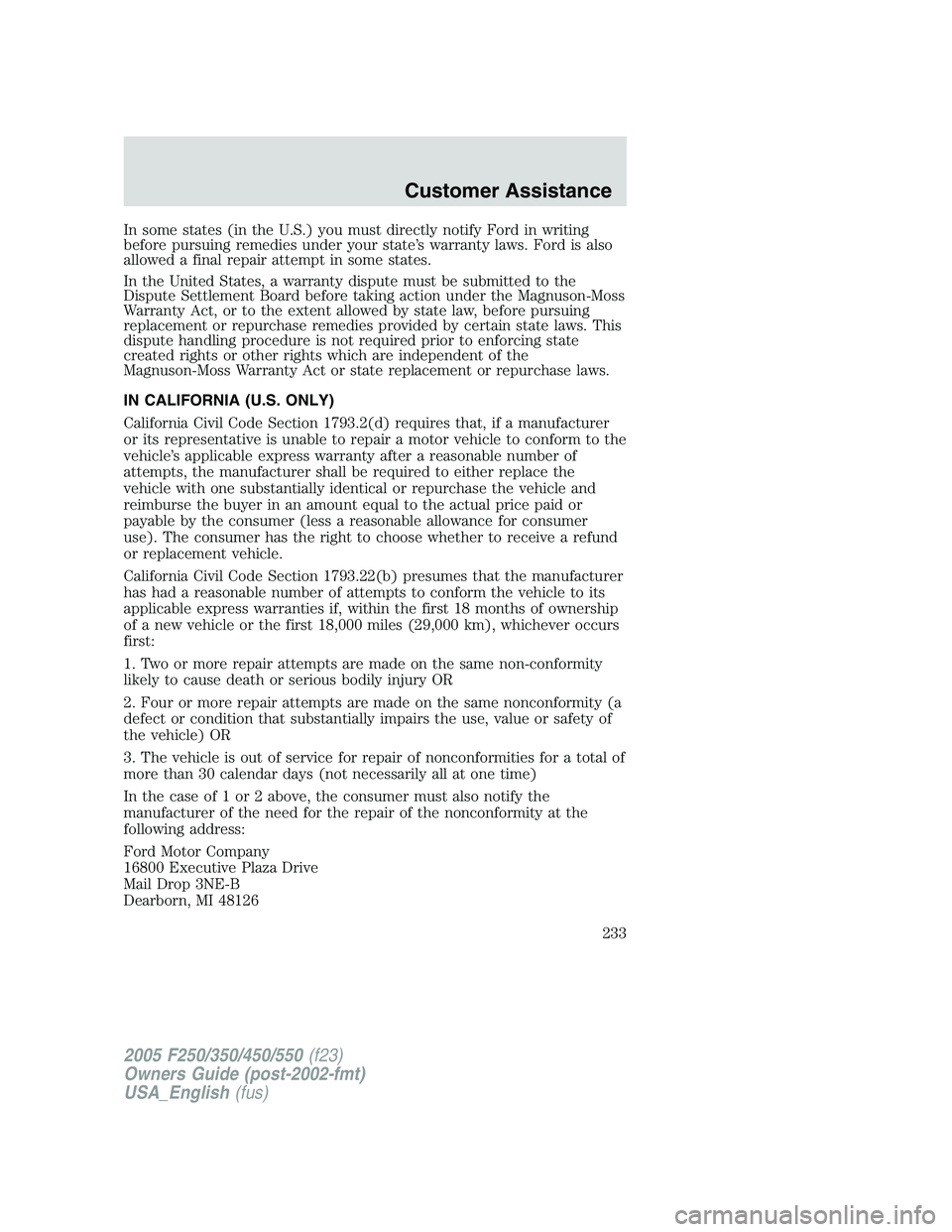
In some states (in the U.S.) you must directly notify Ford in writing
before pursuing remedies under your state’s warranty laws. Ford is also
allowed a final repair attempt in some states.
In the United States, a warranty dispute must be submitted to the
Dispute Settlement Board before taking action under the Magnuson-Moss
Warranty Act, or to the extent allowed by state law, before pursuing
replacement or repurchase remedies provided by certain state laws. This
dispute handling procedure is not required prior to enforcing state
created rights or other rights which are independent of the
Magnuson-Moss Warranty Act or state replacement or repurchase laws.
IN CALIFORNIA (U.S. ONLY)
California Civil Code Section 1793.2(d) requires that, if a manufacturer
or its representative is unable to repair a motor vehicle to conform to the
vehicle’s applicable express warranty after a reasonable number of
attempts, the manufacturer shall be required to either replace the
vehicle with one substantially identical or repurchase the vehicle and
reimburse the buyer in an amount equal to the actual price paid or
payable by the consumer (less a reasonable allowance for consumer
use). The consumer has the right to choose whether to receive a refund
or replacement vehicle.
California Civil Code Section 1793.22(b) presumes that the manufacturer
has had a reasonable number of attempts to conform the vehicle to its
applicable express warranties if, within the first 18 months of ownership
of a new vehicle or the first 18,000 miles (29,000 km), whichever occurs
first:
1. Two or more repair attempts are made on the same non-conformity
likely to cause death or serious bodily injury OR
2. Four or more repair attempts are made on the same nonconformity (a
defect or condition that substantially impairs the use, value or safety of
the vehicle) OR
3. The vehicle is out of service for repair of nonconformities for a total of
more than 30 calendar days (not necessarily all at one time)
In the case of 1 or 2 above, the consumer must also notify the
manufacturer of the need for the repair of the nonconformity at the
following address:
Ford Motor Company
16800 Executive Plaza Drive
Mail Drop 3NE-B
Dearborn, MI 48126
2005 F250/350/450/550 (f23)
Owners Guide (post-2002-fmt)
USA_English (fus) Customer Assistance
233
Page 262 of 312
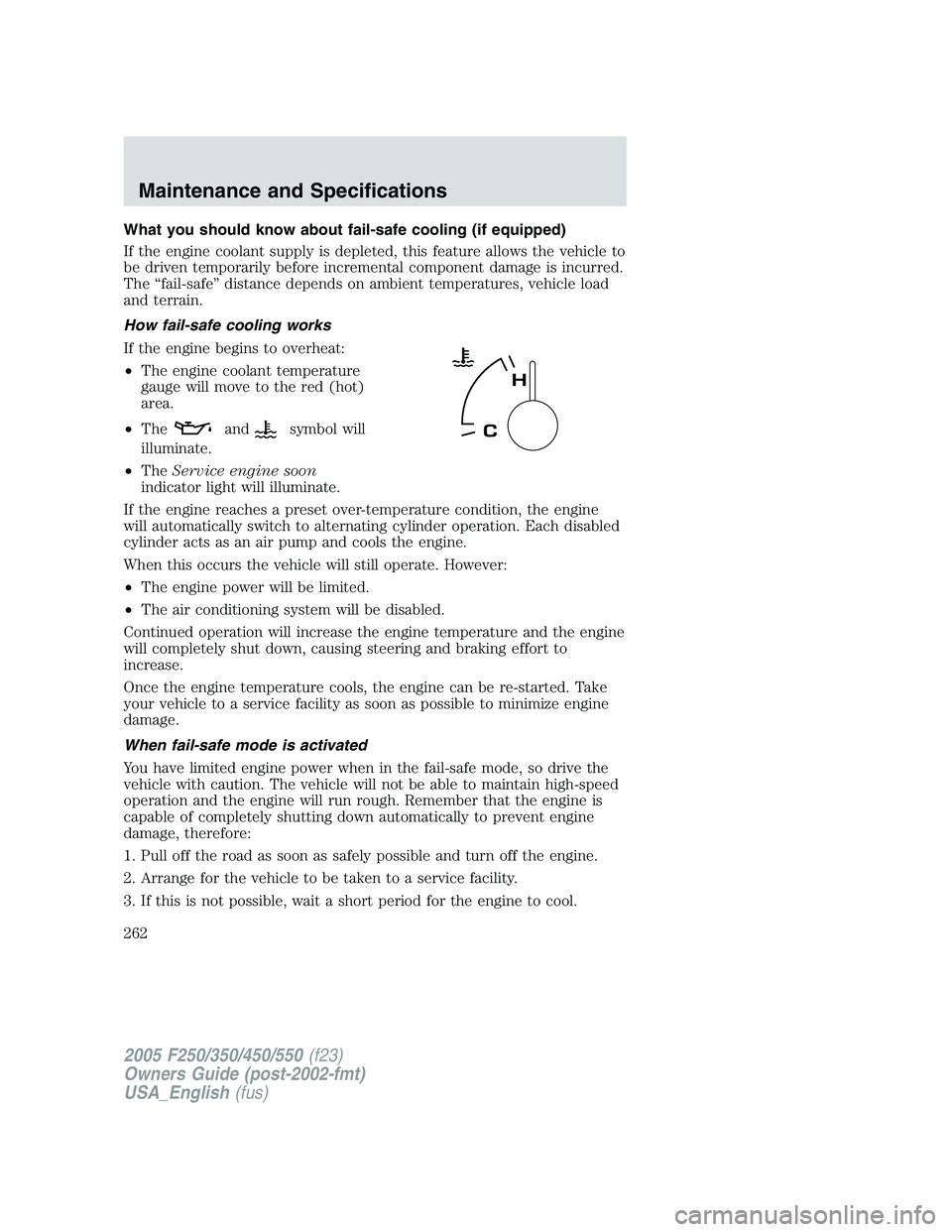
What you should know about fail-safe cooling (if equipped)
If the engine coolant supply is depleted, this feature allows the vehicle to
be driven temporarily before incremental component damage is incurred.
The “fail-safe” distance depends on ambient temperatures, vehicle load
and terrain.
How fail-safe cooling works
If the engine begins to overheat:
• The engine coolant temperature
gauge will move to the red (hot)
area.
• The and symbol will
illuminate.
• The Service engine soon
indicator light will illuminate.
If the engine reaches a preset over-temperature condition, the engine
will automatically switch to alternating cylinder operation. Each disabled
cylinder acts as an air pump and cools the engine.
When this occurs the vehicle will still operate. However:
• The engine power will be limited.
• The air conditioning system will be disabled.
Continued operation will increase the engine temperature and the engine
will completely shut down, causing steering and braking effort to
increase.
Once the engine temperature cools, the engine can be re-started. Take
your vehicle to a service facility as soon as possible to minimize engine
damage.
When fail-safe mode is activated
You have limited engine power when in the fail-safe mode, so drive the
vehicle with caution. The vehicle will not be able to maintain high-speed
operation and the engine will run rough. Remember that the engine is
capable of completely shutting down automatically to prevent engine
damage, therefore:
1. Pull off the road as soon as safely possible and turn off the engine.
2. Arrange for the vehicle to be taken to a service facility.
3. If this is not possible, wait a short period for the engine to cool.
2005 F250/350/450/550 (f23)
Owners Guide (post-2002-fmt)
USA_English (fus)Maintenance and Specifications
262
Page 266 of 312
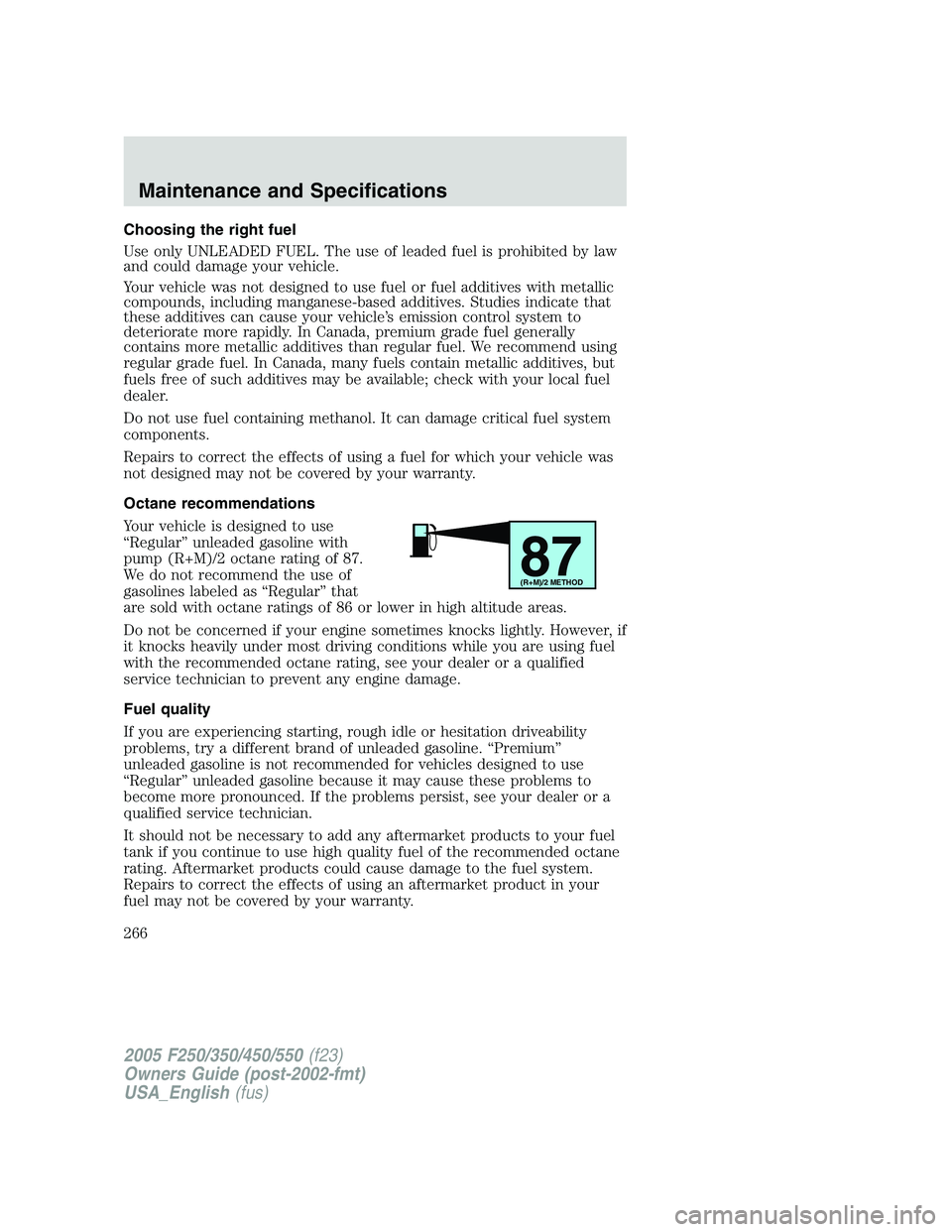
Choosing the right fuel
Use only UNLEADED FUEL. The use of leaded fuel is prohibited by law
and could damage your vehicle.
Your vehicle was not designed to use fuel or fuel additives with metallic
compounds, including manganese-based additives. Studies indicate that
these additives can cause your vehicle’s emission control system to
deteriorate more rapidly. In Canada, premium grade fuel generally
contains more metallic additives than regular fuel. We recommend using
regular grade fuel. In Canada, many fuels contain metallic additives, but
fuels free of such additives may be available; check with your local fuel
dealer.
Do not use fuel containing methanol. It can damage critical fuel system
components.
Repairs to correct the effects of using a fuel for which your vehicle was
not designed may not be covered by your warranty.
Octane recommendations
Your vehicle is designed to use
“Regular” unleaded gasoline with
pump (R+M)/2 octane rating of 87.
We do not recommend the use of
gasolines labeled as “Regular” that
are sold with octane ratings of 86 or lower in high altitude areas.
Do not be concerned if your engine sometimes knocks lightly. However, if
it knocks heavily under most driving conditions while you are using fuel
with the recommended octane rating, see your dealer or a qualified
service technician to prevent any engine damage.
Fuel quality
If you are experiencing starting, rough idle or hesitation driveability
problems, try a different brand of unleaded gasoline. “Premium”
unleaded gasoline is not recommended for vehicles designed to use
“Regular” unleaded gasoline because it may cause these problems to
become more pronounced. If the problems persist, see your dealer or a
qualified service technician.
It should not be necessary to add any aftermarket products to your fuel
tank if you continue to use high quality fuel of the recommended octane
rating. Aftermarket products could cause damage to the fuel system.
Repairs to correct the effects of using an aftermarket product in your
fuel may not be covered by your warranty.
87 (R+M)/2 METHOD
2005 F250/350/450/550 (f23)
Owners Guide (post-2002-fmt)
USA_English (fus)Maintenance and Specifications
266
Page 269 of 312
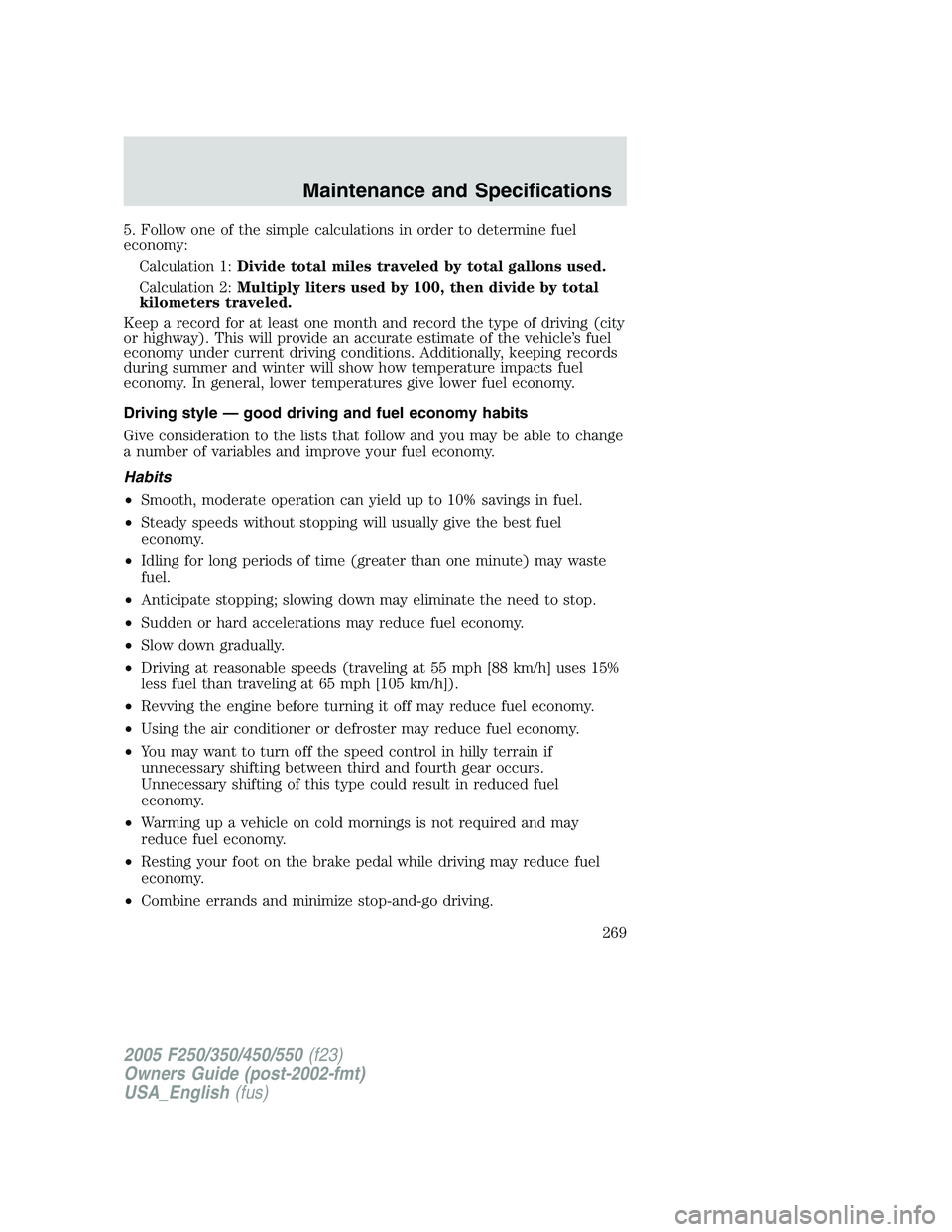
5. Follow one of the simple calculations in order to determine fuel
economy:
Calculation 1: Divide total miles traveled by total gallons used.
Calculation 2: Multiply liters used by 100, then divide by total
kilometers traveled.
Keep a record for at least one month and record the type of driving (city
or highway). This will provide an accurate estimate of the vehicle’s fuel
economy under current driving conditions. Additionally, keeping records
during summer and winter will show how temperature impacts fuel
economy. In general, lower temperatures give lower fuel economy.
Driving style — good driving and fuel economy habits
Give consideration to the lists that follow and you may be able to change
a number of variables and improve your fuel economy.
Habits
• Smooth, moderate operation can yield up to 10% savings in fuel.
• Steady speeds without stopping will usually give the best fuel
economy.
• Idling for long periods of time (greater than one minute) may waste
fuel.
• Anticipate stopping; slowing down may eliminate the need to stop.
• Sudden or hard accelerations may reduce fuel economy.
• Slow down gradually.
• Driving at reasonable speeds (traveling at 55 mph [88 km/h] uses 15%
less fuel than traveling at 65 mph [105 km/h]).
• Revving the engine before turning it off may reduce fuel economy.
• Using the air conditioner or defroster may reduce fuel economy.
• You may want to turn off the speed control in hilly terrain if
unnecessary shifting between third and fourth gear occurs.
Unnecessary shifting of this type could result in reduced fuel
economy.
• Warming up a vehicle on cold mornings is not required and may
reduce fuel economy.
• Resting your foot on the brake pedal while driving may reduce fuel
economy.
• Combine errands and minimize stop-and-go driving.
2005 F250/350/450/550 (f23)
Owners Guide (post-2002-fmt)
USA_English (fus) Maintenance and Specifications
269
Page 302 of 312
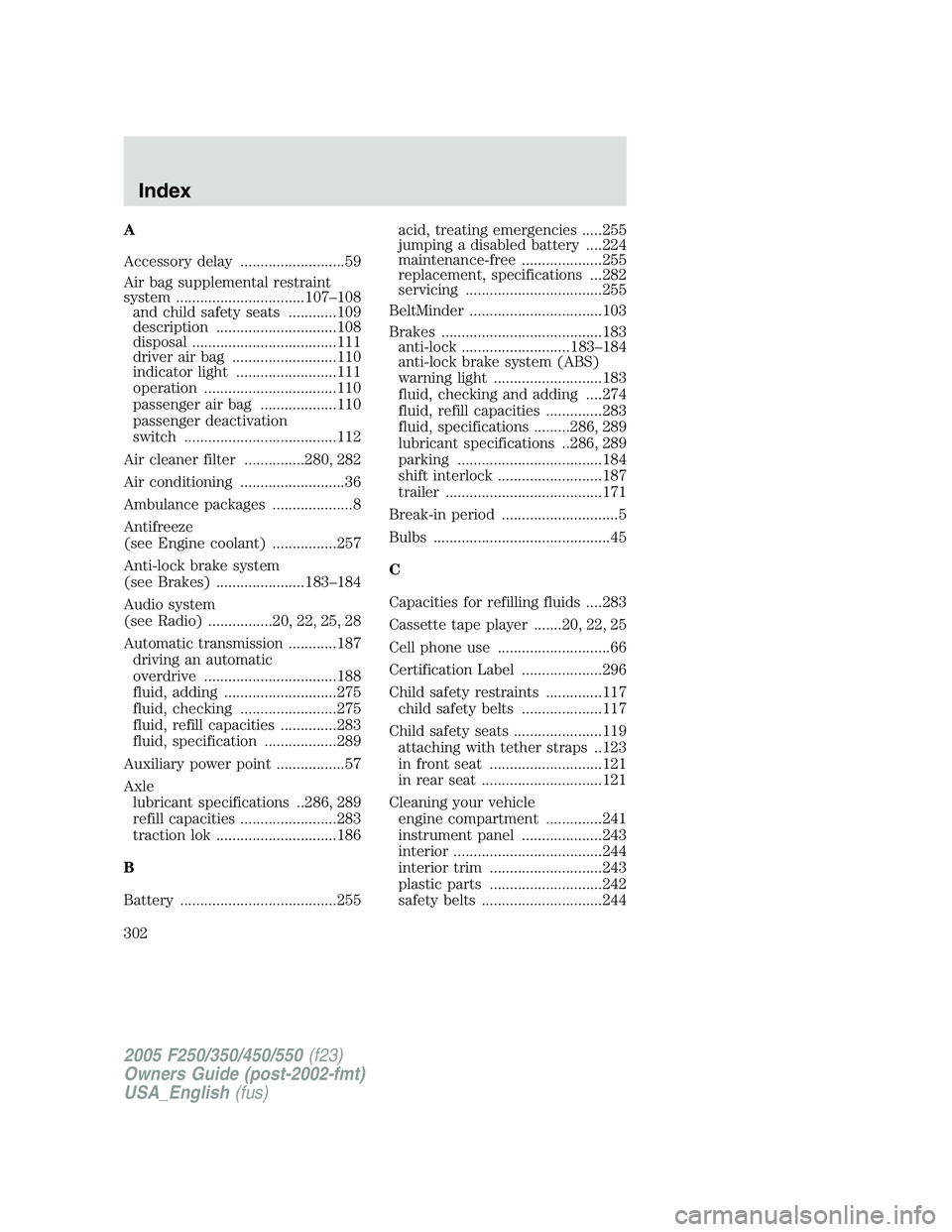
A
Accessory delay ..........................59
Air bag supplemental restraint
system ................................107–108
and child safety seats ............109
description ..............................108
disposal ....................................111
driver air bag ..........................110
indicator light .........................111
operation .................................110
passenger air bag ...................110
passenger deactivation
switch ......................................112
Air cleaner filter ...............280, 282
Air conditioning ..........................36
Ambulance packages ....................8
Antifreeze
(see Engine coolant) ................257
Anti-lock brake system
(see Brakes) ......................183–184
Audio system
(see Radio) ................20, 22, 25, 28
Automatic transmission ............187
driving an automatic
overdrive .................................188
fluid, adding ............................275
fluid, checking ........................275
fluid, refill capacities ..............283
fluid, specification ..................289
Auxiliary power point .................57
Axle
lubricant specifications ..286, 289
refill capacities ........................283
traction lok ..............................186
B
Battery .......................................255 acid, treating emergencies .....255
jumping a disabled battery ....224
maintenance-free ....................255
replacement, specifications ...282
servicing ..................................255
BeltMinder .................................103
Brakes ........................................183
anti-lock ...........................183–184
anti-lock brake system (ABS)
warning light ...........................183
fluid, checking and adding ....274
fluid, refill capacities ..............283
fluid, specifications .........286, 289
lubricant specifications ..286, 289
parking ....................................184
shift interlock ..........................187
trailer .......................................171
Break-in period .............................5
Bulbs ............................................45
C
Capacities for refilling fluids ....283
Cassette tape player .......20, 22, 25
Cell phone use ............................66
Certification Label ....................296
Child safety restraints ..............117
child safety belts ....................117
Child safety seats ......................119
attaching with tether straps ..123
in front seat ............................121
in rear seat ..............................121
Cleaning your vehicle
engine compartment ..............241
instrument panel ....................243
interior .....................................244
interior trim ............................243
plastic parts ............................242
safety belts ..............................244
2005 F250/350/450/550 (f23)
Owners Guide (post-2002-fmt)
USA_English (fus)Index
Index
302
Page 303 of 312
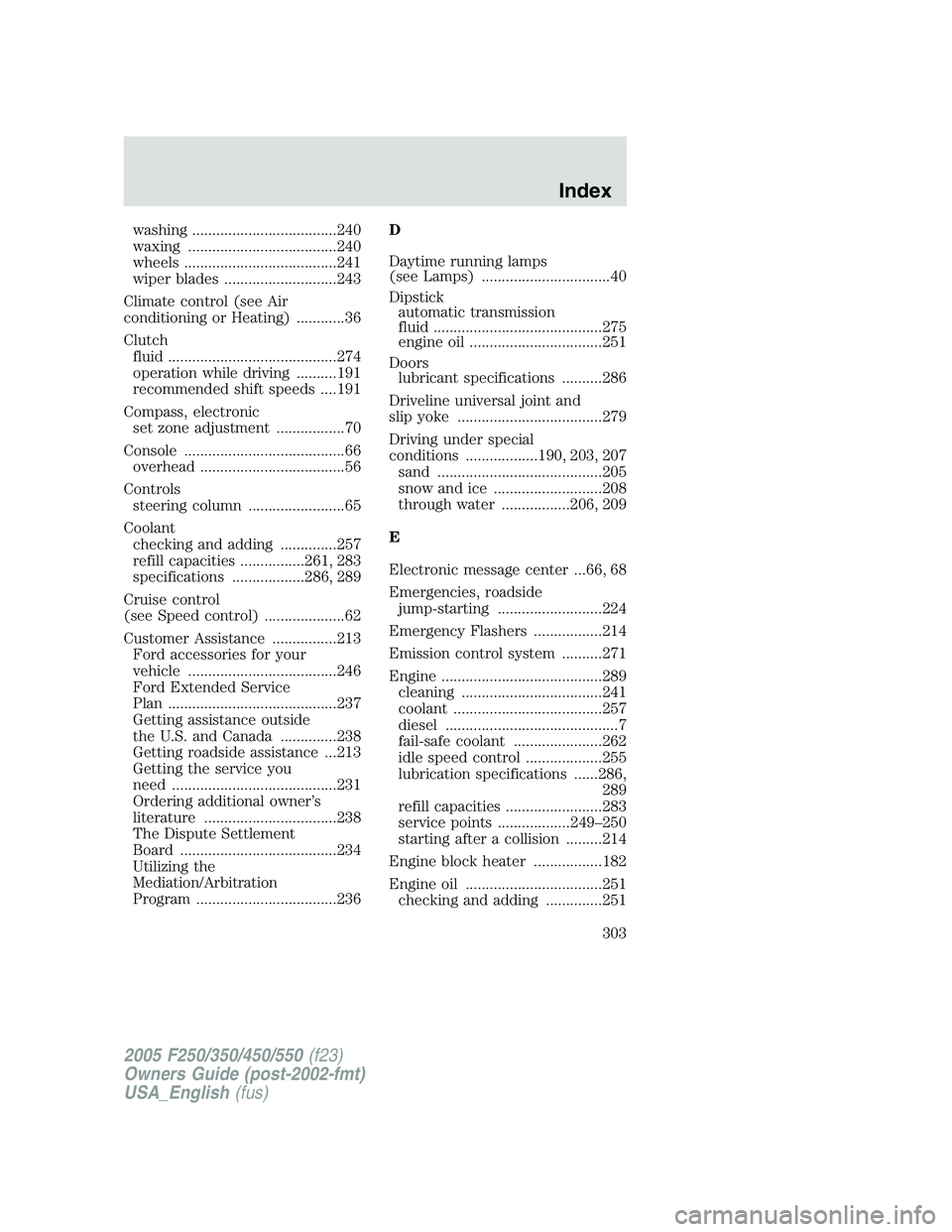
washing ....................................240
waxing .....................................240
wheels ......................................241
wiper blades ............................243
Climate control (see Air
conditioning or Heating) ............36
Clutch
fluid ..........................................274
operation while driving ..........191
recommended shift speeds ....191
Compass, electronic
set zone adjustment .................70
Console ........................................66
overhead ....................................56
Controls
steering column ........................65
Coolant
checking and adding ..............257
refill capacities ................261, 283
specifications ..................286, 289
Cruise control
(see Speed control) ....................62
Customer Assistance ................213
Ford accessories for your
vehicle .....................................246
Ford Extended Service
Plan ..........................................237
Getting assistance outside
the U.S. and Canada ..............238
Getting roadside assistance ...213
Getting the service you
need .........................................231
Ordering additional owner’s
literature .................................238
The Dispute Settlement
Board .......................................234
Utilizing the
Mediation/Arbitration
Program ...................................236 D
Daytime running lamps
(see Lamps) ................................40
Dipstick
automatic transmission
fluid ..........................................275
engine oil .................................251
Doors
lubricant specifications ..........286
Driveline universal joint and
slip yoke ....................................279
Driving under special
conditions ..................190, 203, 207
sand .........................................205
snow and ice ...........................208
through water .................206, 209
E
Electronic message center ...66, 68
Emergencies, roadside
jump-starting ..........................224
Emergency Flashers .................214
Emission control system ..........271
Engine ........................................289
cleaning ...................................241
coolant .....................................257
diesel ...........................................7
fail-safe coolant ......................262
idle speed control ...................255
lubrication specifications ......286,
289
refill capacities ........................283
service points ..................249–250
starting after a collision .........214
Engine block heater .................182
Engine oil ..................................251
checking and adding ..............251
2005 F250/350/450/550 (f23)
Owners Guide (post-2002-fmt)
USA_English (fus) Index
303
Page 304 of 312
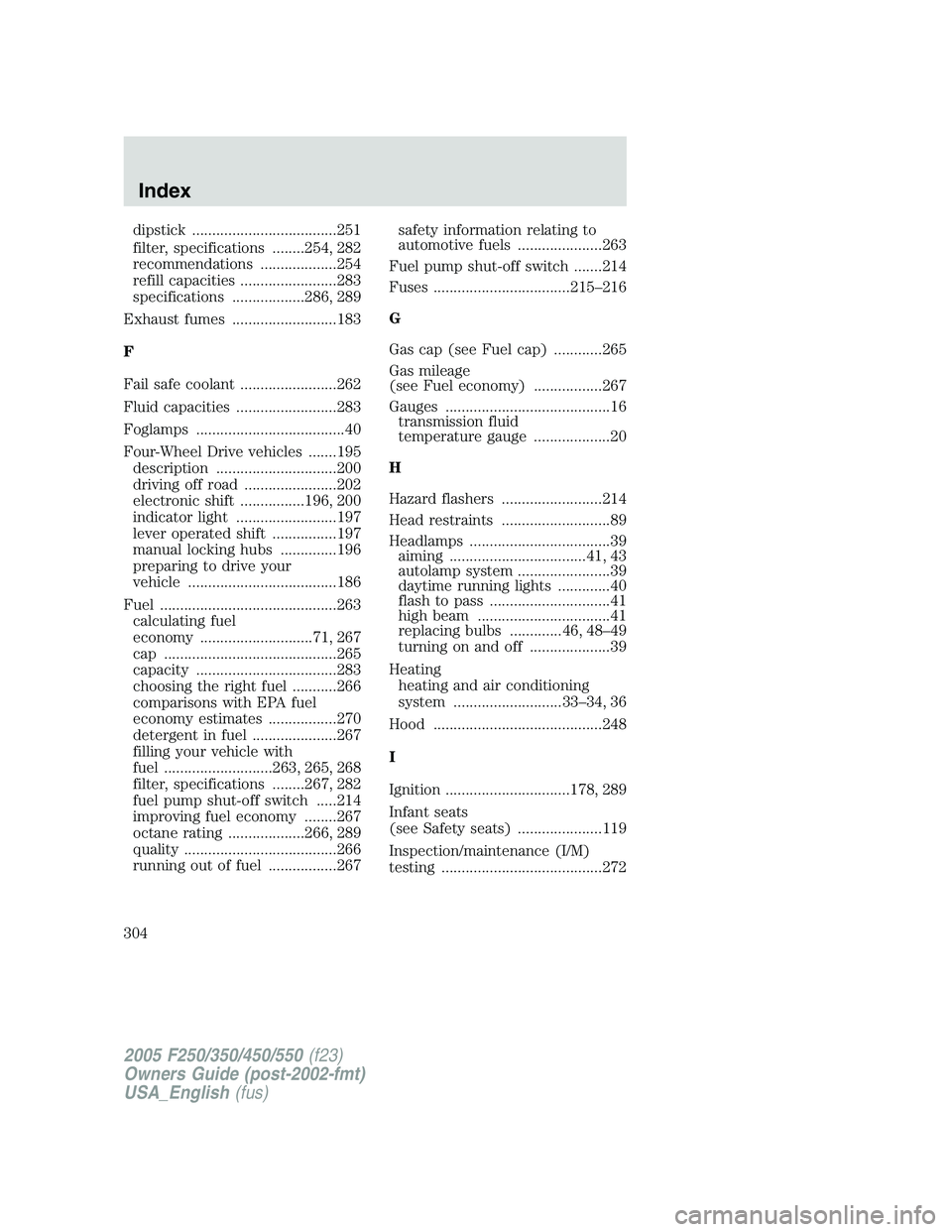
dipstick ....................................251
filter, specifications ........254, 282
recommendations ...................254
refill capacities ........................283
specifications ..................286, 289
Exhaust fumes ..........................183
F
Fail safe coolant ........................262
Fluid capacities .........................283
Foglamps .....................................40
Four-Wheel Drive vehicles .......195
description ..............................200
driving off road .......................202
electronic shift ................196, 200
indicator light .........................197
lever operated shift ................197
manual locking hubs ..............196
preparing to drive your
vehicle .....................................186
Fuel ............................................263
calculating fuel
economy ............................71, 267
cap ...........................................265
capacity ...................................283
choosing the right fuel ...........266
comparisons with EPA fuel
economy estimates .................270
detergent in fuel .....................267
filling your vehicle with
fuel ...........................263, 265, 268
filter, specifications ........267, 282
fuel pump shut-off switch .....214
improving fuel economy ........267
octane rating ...................266, 289
quality ......................................266
running out of fuel .................267 safety information relating to
automotive fuels .....................263
Fuel pump shut-off switch .......214
Fuses ..................................215–216
G
Gas cap (see Fuel cap) ............265
Gas mileage
(see Fuel economy) .................267
Gauges .........................................16
transmission fluid
temperature gauge ...................20
H
Hazard flashers .........................214
Head restraints ...........................89
Headlamps ...................................39
aiming ..................................41, 43
autolamp system .......................39
daytime running lights .............40
flash to pass ..............................41
high beam .................................41
replacing bulbs .............46, 48–49
turning on and off ....................39
Heating
heating and air conditioning
system ...........................33–34, 36
Hood ..........................................248
I
Ignition ...............................178, 289
Infant seats
(see Safety seats) .....................119
Inspection/maintenance (I/M)
testing ........................................272
2005 F250/350/450/550 (f23)
Owners Guide (post-2002-fmt)
USA_English (fus)Index
304